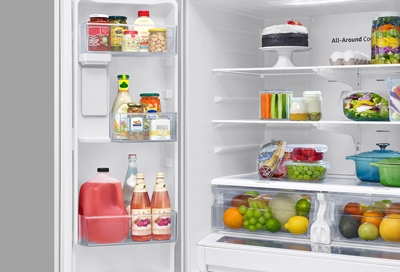To fix a refrigerator that is hot between the doors, ensure the condenser coils are clean and that the appliance is not overloaded. Verify adequate ventilation and check the condenser fan for functionality.
A hot refrigerator can be a sign of energy waste and potential cooling issues. This often-overlooked problem may lead to your fridge working harder than necessary, increasing electricity bills and possibly shortening its lifespan. The warmth between the doors typically arises from the heat dissipation process, which can become compromised when the appliance’s components aren’t functioning optimally.
Tackling this issue promptly not only preserves the contents of your refrigerator but also contributes to its energy efficiency. Understanding and maintaining key parts like condenser coils, the condenser fan, and the appliance’s seal can prevent overheating and ensure your fridge remains in top condition.
Symptoms Of A Heat Issue In Refrigerators
Noticing unusual warmth between your refrigerator doors? This could suggest a heat issue. It’s vital to address this quickly to prevent food spoilage and extend your refrigerator’s life.
Warm Spots Between Doors
Finding warm spots between the fridge doors is a clear sign that something’s not quite right. These are the points to check:
- Surface temperature feels higher than the rest of the unit
- Increased heat when the compressor is running
- Seals around the doors are not cool to the touch
Potential Causes Of Excessive Heat
Several factors could be causing your refrigerator to overheat. Here’s what to investigate:
| Component | Potential Issue |
|---|---|
| Condenser Coils | Dust buildup leading to poor heat dissipation |
| Condenser Fan | Malfunctioning or blocked, reducing airflow |
| Door Seals | Wear and tear, allowing warm air to enter |
| Thermostat | Incorrect settings increasing internal temperature |

Credit: www.samsung.com
Safety First: Preparatory Measures
Before diving into fixing a hot refrigerator door, safety is paramount. Taking the right steps ensures you avoid any risks of electrical shocks or damage. Follow these guidelines to prepare for a safe repair.
Unplugging And Safety Precautions
Safety takes the front seat in any repair task. With a refrigerator, the first step is always to disconnect it from the power source. This move protects you from electrical hazards and preserves the appliance’s integrity.
- Switch off the refrigerator.
- Unplug from the wall outlet carefully.
- Wait for any internal mechanisms to stop completely.
Tools And Materials Needed
With the refrigerator unplugged, gather the tools and materials you’ll need. The right set ensures a smooth repair process.
| Tool/Material | Use |
|---|---|
| Screwdrivers | Disassembling components |
| Vacuum cleaner with brush | Cleaning dust and debris |
| Cleaning cloth | Wiping surfaces |
| Condenser coil brush | Cleaning the coils |
Ensure each tool is in good condition. Gloves and goggles offer additional protection.
Inspecting The Condenser Coils
Does your refrigerator feel hot between the doors? It’s likely an issue with your condenser coils. Inspecting the condenser coils is the first step to cool things down. Let’s roll up our sleeves and get to work on finding and tidying up those coils!
Locating The Coils
Condenser coils release heat from your fridge. It’s crucial to find them before proceeding. Most refrigerators have coils behind a kick plate or at the back. Some models feature coils underneath. Unplug your fridge before you begin.
Cleaning Techniques
Clean coils ensure efficient fridge performance. Use these simple steps for a clean and happy refrigerator:
- Remove the cover: Unscrew the kick plate or move the fridge for rear access.
- Dust off: Use a coil brush or vacuum attachment to gently remove dust.
- Wipe down: With a damp cloth, clean off any remaining grime.
- Replace the cover: Secure the kick plate or push your fridge back in place.
Aim to clean your coils every six months. Your fridge will thank you with cold drinks and fresh food!
Checking The Door Seals
A refrigerator that’s hot between the doors may signal an issue with the door seals. Proper seals keep cold air in and prevent warm air from entering. Let’s delve into how you can maintain your refrigerator’s efficiency by assessing and cleaning the door seals.
Identify Seal Damage
The first step is inspecting door seals for damage. Search for cracks, tears, or warping that can compromise the seal’s integrity. Even small imperfections can lead to significant heat leaks. Use these steps:
- Inspect the entire length of the seals.
- Look for signs of wear or aging.
- Feel for any drafts coming from edges.
If damage appears, seal replacement becomes necessary to rectify the heat issue.
Effective Seal Cleaning
Clean seals promote optimal performance. Dirt buildup can prevent a tight seal. Use warm, soapy water for cleaning. Follow these simple steps:
- Dip a soft cloth in warm soapy water.
- Gently wipe down the seals to remove debris.
- Dry the seals thoroughly with a clean towel.
| Cleaning Step | Tools Needed | Frequency |
|---|---|---|
| Wipe Seals | Soft Cloth | Monthly |
| Inspect Seals | Eyes/Hands | Bi-Monthly |
| Dry Seals | Clean Towel | After every clean |
Regular maintenance is key to ensuring your refrigerator remains cool and efficient. Stick to the checklist above for the best results.
Evaluating The Cooling Fan
Evaluating the cooling fan in your refrigerator is crucial. A hot space between the doors signals a fan problem. The fan distributes cool air properly, keeping your appliance running efficiently. Let’s delve into fan location and inspection to maintain your refrigerator’s health.
Fan Location And Inspection
First, locate the fan behind the fridge’s rear panel. Unplug your fridge. Remove the panel with care. You will see the fan housed next to the coils. Check for dust or debris. A clean fan ensures a cool fridge.
Visual checks can reveal obstructions. Safety is paramount: always disconnect power before you begin.
- Look for blockages: Clear any visible obstruction.
- Examine blades: They must be intact and secure.
- Check wiring: It should be undamaged and connected.
Troubleshooting Fan Issues
Begin troubleshooting by spinning the fan manually. A good fan turns smoothly. Resistance or noise means a replacement is due. Use a multimeter to test for electrical continuity. A failed test confirms a faulty fan.
| Issue | Action |
|---|---|
| Noise or resistance | Consider fan replacement |
| Failed continuity test | Replace fan |
| Wiring damage | Secure connections or contact a technician |
Replacing a fan requires exact model matches. Check the manufacturer’s manual for specifications. Contact an expert for complex issues. Regular fan maintenance prevents future heat problems. Keep your refrigerator running cool with these essential checks.

Credit: m.facebook.com
Advanced Solutions
If your refrigerator feels warm between the doors, you’re dealing with more than just a minor nuisance. This heat can indicate that your fridge is working harder than it should. This can lead to increased energy bills and reduced lifespan of your appliance. Let’s dive into some advanced solutions that can help bring back the chill to your refrigerator.
Adjusting The Fridge’s Level
An uneven fridge can disrupt function. Here’s how to level it:
- Find the leveling legs or rollers beneath the unit.
- Use a wrench to adjust these legs.
- Aim for a slight tilt back to assist door closure.
Ensuring your fridge is level promotes optimal operation and can fix excessive heat between doors.
When To Call A Professional
If the heat persists, it’s a sign to consult an expert. Here’s when to seek professional help:
| Issue | Action |
|---|---|
| Continued heat after troubleshooting | Contact a certified technician. |
| Strange noises or excessive cycling | Schedule a service appointment. |
| Signs of electrical faults | Unplug and call for immediate service. |
Professional insight can save your refrigerator from further damage.
Maintenance To Prevent Future Heat Problems
A hot refrigerator strip between the doors signals an issue. It’s often a quick fix. Maintenance can stop this issue before it starts. Here’s how to keep a fridge running smoothly and cool.
Regular Cleaning Schedule
Cleanliness is key for a well-running fridge. Dust and debris can block airflow. This makes a fridge work harder. A hot strip often follows.
- Wipe down the fridge exterior monthly.
- Clean the coils, found at the back or bottom.
- Unplug the fridge for safety. Use a coil brush.
- Vacuum any remaining dirt. Do this seasonally.
Cleaning gaskets, or door seals, is important. Use a mild soap solution. Dry them thoroughly. This helps keep the seal tight and the doors properly closed.
Monitoring Temperature And Performance
Keeping an eye on the fridge’s climate stops issues from growing. A consistent temperature keeps the strip cool.
| Location | Temperature |
|---|---|
| Fridge | 3°C to 4°C |
| Freezer | -18°C |
Install a fridge thermometer for accurate readings. Check it weekly. Note any major changes. They can indicate a problem.
A fridge’s performance matters. Listen for unusual sounds. Feel for excessive heat. These signs need attention. Perform routine checks and respond quickly to potential issues.

Credit: www.bobvila.com
Frequently Asked Questions Of How To Fix A Refrigerator That Is Hot Between The Doors
Why Is My Fridge Hot Between Doors?
Increased heat between the fridge doors often stems from condenser coils needing cleaning. If coils accumulate dust or debris, they can’t release heat effectively. Regular maintenance is key.
Can Dirty Door Seals Cause A Fridge To Overheat?
Yes, filthy door seals trap heat and prevent proper door closure. This causes the fridge to work harder, leading to excess heat. Clean seals regularly for optimal performance.
What Role Do Condenser Coils Play In Refrigerator Heating?
Condenser coils release heat from the fridge. If they’re dirty or obstructed, they can’t do this efficiently. This could result in heating between the refrigerator doors.
How Often Should You Clean Fridge Seals And Coils?
For better efficiency and to prevent overheating, clean seals and coils every 3-6 months. However, check your fridge’s manual for specific maintenance recommendations.
Conclusion
Tackling a hot refrigerator door issue can be straightforward. Our guide provides the steps to cool down your appliance efficiently. Remember, regular maintenance prevents future problems. For further assistance, consult a professional. Keep your fridge running smoothly with these easy fixes.

